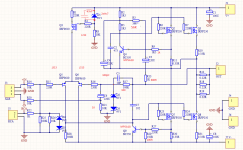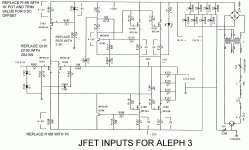Gate stoppers are commonly 100 to 470 ohms. Lower is better for distortion; higher dampens any parasitics faster. I'm not sure how one chooses between the two....
The general idea is to use as small as works, but I've tried 47 to 680r, and haven't ever heard a difference. I have, however, had a not stable amp become more stable with higher values.
I normally use 200r, but only because it's a bit of an odd value and I have a bunch of really nice Mil-spec Dales to use... 😀
I normally use 200r, but only because it's a bit of an odd value and I have a bunch of really nice Mil-spec Dales to use... 😀
well , putting stability issue aside ....... when is the case that I'm finding substantial sound difference between 47R and 220R (or even 270R) , it can be just two things :
-something is wrong with amp elsewhere, or
-my ears are becoming younger
🙂
-something is wrong with amp elsewhere, or
-my ears are becoming younger
🙂
irfp250 instead of irfp240
Greetings to all guys! in my drawer I have some irfp250 can I use them instead of the irfp 240?
Thanks in advance.
Antonio
Greetings to all guys! in my drawer I have some irfp250 can I use them instead of the irfp 240?
Thanks in advance.
Antonio
So no problems?
And about the sonic differences did you notice any difference, especially in the low range?
Thanks
The 250 is equivalent to (2) 240 in the the same package.
And this is no good?
Higher input capacitance for the 250. If you try to replace 2 240s with 1 250 you will overheat the 250 trying to move twice as much heat out of one transistor. It will likely work with 2 sets of 250s per side but all bets are off in terms of stability, bandwidth etc.
Higher input capacitance for the 250. If you try to replace 2 240s with 1 250 you will overheat the 250 trying to move twice as much heat out of one transistor. It will likely work with 2 sets of 250s per side but all bets are off in terms of stability, bandwidth etc.
I only need to replace irfp240 with 250 using the same number of devices, simply because I already own them.
Higher input capacitance for the 250. If you try to replace 2 240s with 1 250 you will overheat the 250 trying to move twice as much heat out of one transistor. It will likely work with 2 sets of 250s per side but all bets are off in terms of stability, bandwidth etc.
This is an exemple of their use in Aleph 3
Attachments
The original Aleph 3 did not use IRFP250.
In any case if you want to use a pair of IRFP250 you probably should check
if the current from the front end is adequate in driving the doubled
capacitance.
In any case if you want to use a pair of IRFP250 you probably should check
if the current from the front end is adequate in driving the doubled
capacitance.
The original Aleph 3 did not use IRFP250.
In any case if you want to use a pair of IRFP250 you probably should check
if the current from the front end is adequate in driving the doubled
capacitance.
Ok Thanks for your information.
The Aleph 3 uses a different front end that runs at a higher current(20ma current source) than the Aleph J.
And the Aleph-J front end runs at less than 9mA. (Forgot to mention that.)
So it's not really possible by arranging something similar with irfp250 or simply using two 250 instead of four 240?
In case it be possible to use only two 250 (with the natural consequences on dissipation) should I change the value of the power resistors?
Attachments
- Home
- Amplifiers
- Pass Labs
- Aleph J illustrated build guide


